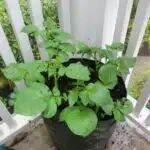Are you looking to achieve the Garden of Eden in your own backyard? Growing the most flavorful eggplants just might be the key to unlocking it! With its unique flavor and texture, this versatile vegetable is a favorite among gardeners, chefs, and home cooks alike. But how do you grow the most flavorful eggplants? Don’t worry; we’ve got you covered.
This article will give you all the information you need to get started on growing flavorful eggplants that will have your neighbors envious of your green thumb. From choosing the right variety of eggplant to making sure it receives adequate water and nutrients, we’ll cover everything needed to make sure your garden yields the most delicious crop possible.
So don’t be intimidated by growing eggplants; with our step-by-step guide, you’ll be a master gardener in no time. Read on to unlock the secret of growing the most flavorful eggplants in your very own backyard!
1. Understanding Eggplants
Oh my goodness! Eggplants can be so complicated to grow! With the right knowledge, however, you could be growing the most flavorful eggplants of your life. Understanding eggplants is crucial for growing those delicious vegetables.
First of all, you need to understand eggplant’s growth cycle. Eggplants take a long time to mature – around 75-90 days on average – and they should be planted in warm soil with temperatures between 60 and 85 degrees Fahrenheit. Knowing this key information will help you choose the right variety of eggplant for your climate.
The soil pH is also an important factor in growing flavorful eggplants. Eggplants prefer slightly acidic soil with a pH of 6.0-6.8 and they will produce their best flavor if they get plenty of sunshine and water throughout the growing season. Keeping these tips in mind will ensure success when it comes to harvesting those delicious fruits!
With the right understanding of how eggplants grow, you’ll be well on your way to cultivating the most flavorful veggies ever! If you choose the correct variety for your climate and pay attention to its needs throughout the growing process, you’ll have no problem harvesting delicious fruit every time.
2. Choosing The Right Variety
Choosing the right eggplant variety is like selecting a brush to paint with – you’ll never get an amazing painting with the wrong brush. To master the art of growing flavorful eggplants, it’s important to understand which varieties are best suited for your climate and soil type.
When selecting an eggplant variety, consider their origin and climate requirements. Some varieties thrive in warm regions while others prefer cooler climates. Also, some types of eggplants may require more water than others. It’s crucial to choose a variety that will be able to survive in your area.
In addition, take into account the size and shape of the fruits when selecting an eggplant variety. If you’re looking for small, round fruits, there are certain varieties that specialize in this type of fruit production. Similarly, if you want longer, slimmer fruits then look for specific varieties that produce those shapes.
By considering these various factors before planting your seedlings, you can ensure that you have chosen the perfect variety for the best possible flavor outcome. With the right eggplant selection and knowledge of soil preparation, you’re sure to have a bountiful harvest full of delicious vegetables!
3. Preparing The Soil
Gardening is an art that takes patience, knowledge, and skill to master. But it’s also immensely rewarding when you manage to grow something beautiful and flavorful. To make sure your eggplants turn out as delicious as possible, it’s important to take the time to properly prepare the soil. So what’s the secret?
The key lies in understanding what your eggplants need in order to thrive. You’ll want soil that is rich in organic matter such as compost or aged manure, with a pH level between 5.5 and 6.8 for ideal growth. Additionally, soil should be well-drained, yet still retain moisture since eggplants need consistent watering.
To make sure your soil is ready for planting your eggplants, you can do a few simple tests. To check for drainage, dig a small hole about six inches deep and fill it with water – if it drains within 10 minutes then the soil passes! For pH levels, you can use a home testing kit which will provide accurate readings of acidity or alkalinity of your soil. Taking these steps will help ensure that your eggplants will have all the nutrients they need for optimal growth and taste!
4. Planting Your Eggplants
Planting your eggplants is an important step in growing flavorful, healthy fruit. It’s best to plant the seedlings when the soil temperature has reached at least 60°F. When you’re ready to plant, dig a hole that’s twice as deep as the root ball, and mix some compost into the backfill soil. Place each seedling in its own hole, and cover with backfill soil, making sure not to bury the stem too deeply.
Once planted, water your eggplants thoroughly so that the entire root zone is evenly moist. If possible, use a soaker hose or other type of irrigation system to avoid getting water on the leaves so they don’t get mildewy. Mulch around the plants with straw or hay to help keep weeds down and moisture in.
Now that your eggplants are planted properly, it’s time to care for them with regular watering and feeding for optimal growth and flavor development.
5. Watering And Feeding Eggplants
Watering and feeding eggplants is like giving them the nourishment they need to bring out their full flavor. It’s a delicate balance that, when done correctly, can reap delicious rewards.
Regularly watering your eggplants is essential for their growth and success. Make sure you water deeply and consistently so that the soil is moist enough for your plants to thrive. Watering at least once a week should be enough, but more often during dry spells or hot weather. Additionally, you should fertilize your eggplants every two weeks with an all-purpose fertilizer to give them the nutrients they need to grow well and produce tasty fruit.
In order to maintain healthy plants, proper mulching is key. Mulch helps retain moisture in the soil while also keeping weeds at bay. Try using straw or shredded leaves as mulch around the base of your plants, making sure it’s spread evenly and not too thickly so that air can still circulate around the roots. With these simple steps taken care of, you’ll soon be harvesting delicious eggplants in no time!
6. Mulching For Eggplants
Mulching for eggplants is like wrapping presents for the garden. It’s an important step in growing flavorful eggplants that should not be overlooked. When mulching your plants, you’ll want to use organic materials such as straw, shredded leaves, or grass clippings. This will help keep the soil moist and cool in hot temperatures, while also preventing weeds from sprouting. Additionally, it helps retain nutrients in the soil and provides a barrier against pests and diseases.
It’s important to give your eggplant plants enough space when mulching so that air can still flow freely around them. You should also keep mulch away from the stem of the plant as this could cause rot and disease. Finally, make sure to check the moisture level of your mulch regularly as it can dry out quickly depending on the climate conditions.
Mulching is just one part of creating the perfect environment for growing flavorful eggplants. After taking care of this step, you’ll need to consider support and trellising for your plants to ensure they have adequate access to sun and water.
7. Supporting And Trellising Eggplants
Supporting and trellising eggplants is like a gardener’s embrace, gently wrapping around the plants to provide stability and nourishment as they grow. Like a tender hug, these methods protect the plants from any harm while offering them just what they need to thrive.
Using a trellis or stake can help direct the growth of the plant up and off the ground. This improves air circulation, which helps keep diseases away, as well as helping with overall plant health by providing extra nutrients and light. It also keeps the fruits off the ground where pests can access them more easily. When staking or trellising eggplants, it’s important to do so early in their growth cycle as it can be difficult to do when they get larger.
These simple steps are essential for growing flavorful eggplants that are ripe and full of flavor. With proper support and care, eggplants can reach their full potential in terms of flavor and size, giving gardeners bountiful harvests that make their hard work worthwhile. Now that we’ve seen how to support eggplant growth, let’s take a look at controlling pests and diseases for even better results.
8. Controlling Pests And Diseases
The garden is a battlefield, and controlling pests and diseases is the key to victory. As if we were in the trenches, our plants are under siege from myriad foes, threatening to undermine our hard work. But with proper planning and preparation, we can turn the tide of battle for our eggplants.
Let’s start by identifying potential threats before they become an issue. Common culprits include flea beetles, aphids, mites, slugs and snails—all of which can be combated with natural methods like diatomaceous earth or neem oil spray. For larger pests like rabbits or deer, a physical barrier like fencing or netting may be necessary.
Once we’ve set up our protective measures, it’s time to move onto proactive steps. Keeping the soil healthy is essential; mulching helps retain moisture while also fighting off weeds that can compete with our plants for nutrients. Additionally, making sure space between plants allows air to circulate can prevent fungal growth—which leads to rotting fruits. With these strategies in play, our eggplants will have the best chance of success!
9. Knowing When To Harvest
Harvesting eggplants is like trying to pick the ripest apple from a tree. You want to choose the one that has just the right amount of crunch and sweetness. Knowing when to harvest an eggplant is essential for growing flavorful vegetables.
There are a few signs that you can look for when it’s time to pick your eggplants. The skin will become glossy, smooth, and firm and the fruit itself will be heavier than when it was first planted. The stem should also be dry and brittle, which means that the eggplant is ready for picking. Additionally, the size of the fruit will depend on the variety you are growing; some may need to be harvested as soon as they reach a certain length, while others may require more time on the vine before being picked.
Harvesting at just the right time ensures that your eggplants are full of flavor and nutrition. A good rule of thumb is to err on the side of caution when deciding whether or not an eggplant is ripe; if in doubt, wait another day or two before harvesting. This way you can ensure that each vegetable tastes as delicious as possible! With a little patience and practice, you’ll be able to identify exactly when it’s time to pick your perfect eggplant every time. From there, it’s simply a matter of storing them correctly so that they stay fresh for as long as possible.
10. Storing Eggplants
Storing eggplants is an essential step in ensuring their freshness and flavor. It’s important to know the correct way to store them to maximize their taste. But what is the best way to store eggplants? To answer that, let’s take a look at some of the common methods used by experienced gardeners.
One popular way to store eggplants is in a cool, dry place. A garage or basement can be ideal for this purpose, as long as there are no extreme temperatures or humidity levels present. Alternatively, a refrigerator with a temperature setting between 40-50°F is also suitable for storing these vegetables. They should be kept in plastic bags with tiny holes punctured so air can circulate and moisture can escape. Additionally, they should be checked regularly and any signs of spoilage removed immediately.
The key takeaway here is that proper storage plays a pivotal role in preserving the flavor of your eggplant harvest. So it’s important to take into account temperature and humidity when deciding on where to store them for optimal taste. With all this knowledge, you’ll be well-prepared to reap the delicious benefits of your hard work!
11. Best Practices For Growing Eggplants
Growing eggplants is like taking a journey into an unknown world. As you explore, you’ll find a variety of tips and tricks that can help maximize your harvest. Best practices for growing eggplants are the key to unlocking the full potential of this delicious fruit.
When planting eggplants, it’s important to choose a sunny spot with well-draining soil. Planting too deep can lead to problems such as fungal diseases, so be sure to only plant them just below the surface of the soil. Water regularly and mulch heavily to retain moisture and protect against temperature fluctuations. Fertilize every two weeks with a balanced fertilizer for optimal growth.
Eggplants are also susceptible to pests, so be sure to check plants regularly for signs of infestation such as wilting or discoloration. If necessary, use natural methods such as insecticidal soap or neem oil to keep pests away from the plants. With proper care and attention, you can enjoy a healthy and bountiful crop of eggplants each season.
By implementing these best practices for growing eggplants, you can create a thriving garden that yields flavorful fruits throughout the year. Now let’s turn our focus towards companion planting for eggplants — another great way to keep your garden in tip-top shape!
12. Companion Planting For Eggplants
Ready to learn the secret of growing the most flavorful eggplants? Then get ready for a real treat! Companion planting is an exciting way to boost your eggplant harvest. But what exactly is it?
Companion planting is a gardening technique designed to optimize garden space and create beneficial relationships between plants. It works by using companion plants that help each other grow better, while keeping pests away and providing nutrients. For example, tomatoes can help repel flea beetles, which can attack eggplants. Plus, the tomatoes will also provide shade to the eggplants in summer’s hottest months.
In addition to tomatoes, some popular companion plants for eggplants include celery, onions, garlic, radishes, marigolds and nasturtiums. Each of these plants has its own benefits: celery attracts bees; onions ward off aphids; garlic keeps away beetles; radishes attract hoverflies; marigolds repel nematodes; and nasturtiums protect against whiteflies. With all of these helpful companions in your garden, your eggplant crop is sure to thrive!
So why not give companion planting a try this season? You just might be surprised at how much tastier your homegrown eggplants are! And don’t forget – container gardening is another great way to enjoy delicious eggplants without taking up too much space!
13. Container Gardening With Eggplants
Container gardening is a great way to grow eggplants without taking up too much space. The same rules for growing eggplants in the ground apply for container gardening, although you’ll need to pay extra attention to soil drainage and water needs. It’s important to use a pot that has at least one bottom hole and that is big enough for the plant’s root system. For best results, choose larger pots with good drainage and avoid those made of clay because they tend to dry out quickly.
When planting, make sure the soil is moist and mix in some compost or other organic matter. Eggplants require full sun, so position your container in a sunny spot where it will get at least six hours of sunlight each day. Also, be sure to water regularly and feed your plants every few weeks with an all-purpose fertilizer.
Finally, keep an eye on your container-grown eggplants as they grow; if you notice wilting leaves or yellowing fruit, it may be time to repot into a larger container or add more compost to provide better nutrition for the plants. With these tips in mind, you can easily enjoy delicious eggplant harvests from the comfort of your own backyard!
14. Growing Eggplants In Hot Climates
Who would have known that the secret to growing flavorful eggplants is to grow them in hot climates? Imagine, in the sweltering heat, trying to grow delicious vegetables! It’s almost comical, but it’s true – if you want your eggplants to be sweet and succulent, you’ve got to take the heat.
The key is to keep your plants well-watered and shaded from too much sun. You’ll need a soil that can retain moisture throughout the day, as well as provide plenty of nutrients for your plants. Mulch also helps protect the roots of your plants from drying out too quickly. And if you’re planting in pots or containers, make sure they are large enough for good air circulation so that your eggplants don’t become overcrowded.
Growing eggplants in hot climates can be challenging, but with proper care and attention, you can reap the rewards of flavorful fruit in no time at all. And with troubleshooting tips like these, even novice gardeners can have success with their vegetable gardens!
15. Troubleshooting Eggplant Problems
Troubleshooting eggplant problems can be a tricky endeavor. But with the right guidance, you can make sure that your eggplants get the best possible start and optimal growing conditions. The first step is to identify any potential issues. This can include diseases, pests, or nutrient deficiencies that might be hindering growth. Once you’ve identified the problem, you’ll want to take action to remedy it.
Fungal diseases like verticillium wilt or fusarium are common problems in eggplants, and require careful monitoring and treatment. Pests such as aphids or flea beetles can also cause damage if they’re not kept in check. Nutrient deficiencies can also stunt your plants’ growth; applying compost regularly is one way to counter this. Additionally, it’s important to make sure your soil is properly aerated and draining well so that there’s enough oxygen for the roots of your plants to thrive.
By following these steps and offering your eggplants a supportive environment, you’ll be able to reduce or avoid many common issues with growing them. With regular maintenance and attention, you’ll soon have a healthy crop of flavorful eggplants!

Frequently Asked Questions
What Is The Best Soil Ph For Growing Eggplants?
When it comes to growing eggplants, the soil pH is an important factor. It’s a delicate balance that can determine the success of your harvest. But what is the best soil pH for growing eggplants?
The ideal soil pH range for growing eggplants is between 6.0 and 6.5. Eggplants thrive in slightly acidic soil, as it helps breakdown organic matter and makes nutrients like phosphorus more available. A soil with too low of a pH can cause nutrient deficiencies, while a too-high pH can lead to aluminum toxicity or other nutrient issues.
It’s worth noting that certain varieties of eggplant may perform better in different types of soil than others. For example, some may prefer a slightly lower or higher pH than the average range mentioned above. Experimenting with different varieties might be necessary to find out which type works best for you and your garden!
What Is The Optimal Spacing For Planting Eggplants?
When it comes to growing eggplants, spacing is key. Knowing the optimal distance between plants can help ensure they get the space they need to thrive and develop flavorful fruit. While the exact requirements can vary depending on the variety of eggplant being grown, most types should be planted with at least 12-18 inches of space between them.
In order to make sure your eggplants are getting enough room, it’s important to consider how big they’ll get when mature. For example, some varieties can reach up to 3 feet tall and wide, so you’ll want to provide more space if that’s what you’re growing. Additionally, keep in mind that planting too close together can cause your plants to compete for resources such as sunlight and water. This can lead to stunted growth or poor yields, whereas allowing them adequate space will give them a better chance at success.
It’s also important to remember that eggplants like lots of sunlight, so try planting in an area that gets 6-8 hours of direct sun each day. With the right spacing and plenty of sunshine, you’ll be well on your way towards harvesting the most flavorful eggplants!
How Often Should I Water And Feed My Eggplants?
Growing flavorful eggplants can be a challenge, but with the right care, you’ll be rewarded with a delicious bounty. Watering and feeding your plants correctly is an essential step in ensuring that your eggplants produce the best possible flavor. So how often should you water and feed them? Let’s find out.
The key to success lies in giving your eggplants regular attention. Aim to water them every 4-7 days, depending on the weather conditions – more frequent watering may be needed during warm, dry periods. Additionally, make sure to feed them every two weeks using a balanced fertilizer such as a 10-10-10 mix or something similar.
Taking good care of your eggplants will help ensure that they thrive and produce sweet, juicy fruits for you to enjoy! Keep an eye on the soil moisture levels and top up with water when necessary; this will help prevent any wilting of the leaves or stunted growth due to lack of hydration. With enough love and attention, you’ll soon have a crop of succulent eggplants ready for harvesting!
What Type Of Mulch Is Best For Eggplants?
The warm summer sun and the smell of freshly tilled soil signal the start of one of the most delightful gardening activities – growing eggplants. But what type of mulch is best for these delicious vegetables? To ensure your eggplants are as flavorful as possible, it’s important to give them the right environment and nutrients.
Picture a thick layer of straw beneath your eggplant plants, helping to keep moisture in the soil while preventing weeds from sprouting. This type of mulch is ideal for eggplants since it not only helps regulate their temperature, but also protects them from pests. Plus, it breaks down over time and can be used as a natural fertilizer!
For optimal results, add a layer of organic compost or manure to the topsoil before applying your mulch. This will provide your eggplants with essential nutrients that will help them thrive and produce delicious fruits throughout the season. With a little bit of care and attention, you can expect large, juicy eggplants that are sure to please all summer long!
How Long Does It Take For Eggplants To Mature?
Growing eggplants is like a slow dance. It takes time and patience to get the most flavorful harvest, but the reward is worth it. How long does it take for eggplants to mature?
Typically, it takes about three months for eggplants to reach their optimal maturity. When planning your garden, make sure you give them enough space and sunlight, as they need plenty of both to grow up big and strong. They also need consistent watering; too much or too little will affect the taste of your final product.
When it’s time for harvest, look for dark purple, glossy skin with no blemishes or yellowing spots on the fruit. Eggplants should be firm but not hard when touched – a sure sign they’re ripe and ready! With some tender care and plenty of time, you’ll have delicious eggplants in no time at all.
Conclusion
Growing eggplants can be a rewarding experience when done correctly. To ensure the best results, it’s important to pay attention to soil pH, spacing, water and feeding schedules, and mulching. With a few simple steps, you can easily cultivate delicious eggplants that are packed with flavor.
First, maintaining an ideal soil pH of 6.0-6.8 is essential for the success of your eggplant crop. Secondly, make sure to provide adequate space between plants so they can thrive without competing for resources. Thirdly, don’t forget to water and feed your plants regularly and choose the right type of mulch for your location. Finally, remember that eggplants take several weeks or even months before they’re ready to harvest.
By following these tips, you’ll be sure to reap the rewards of homegrown eggplants with succulent taste and texture! So grab your gardening gloves and get planting: flavorful eggplants await!





























